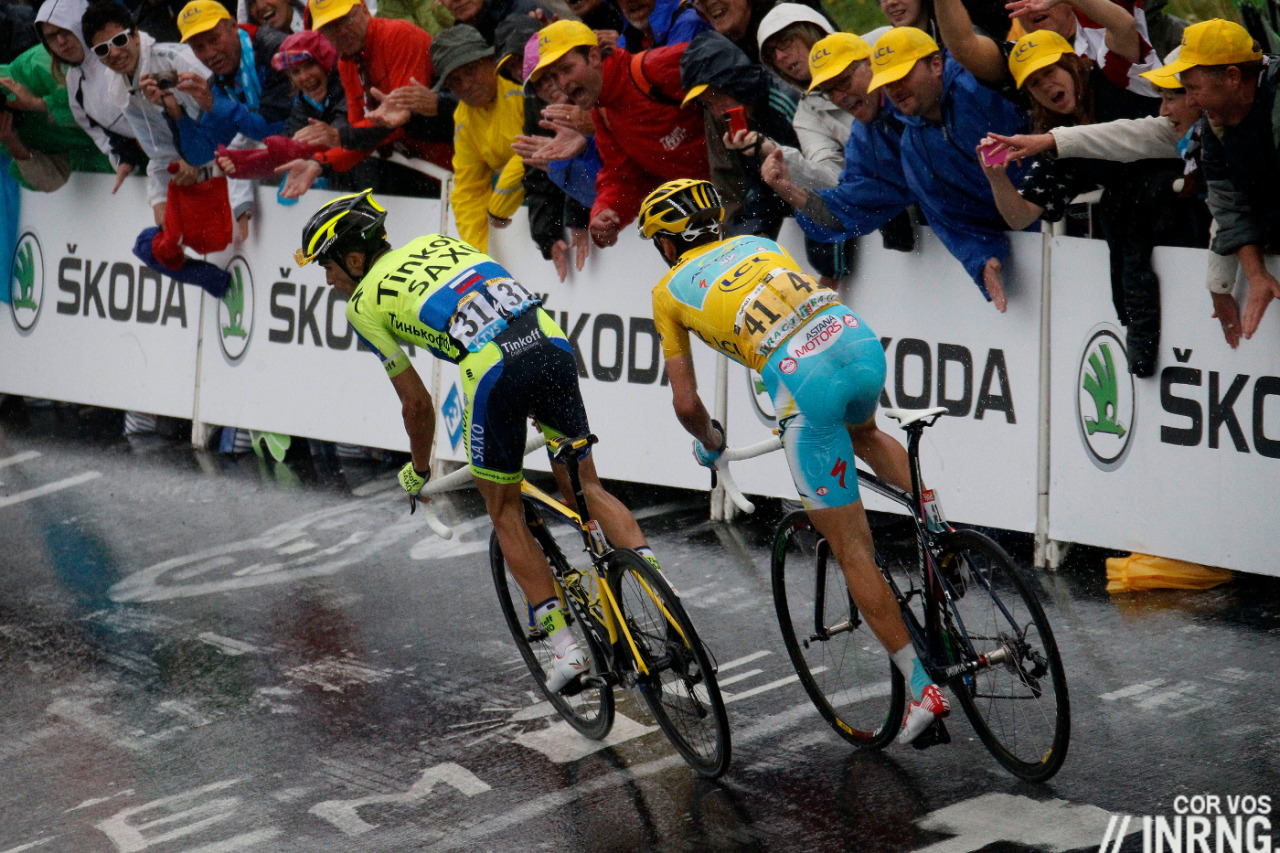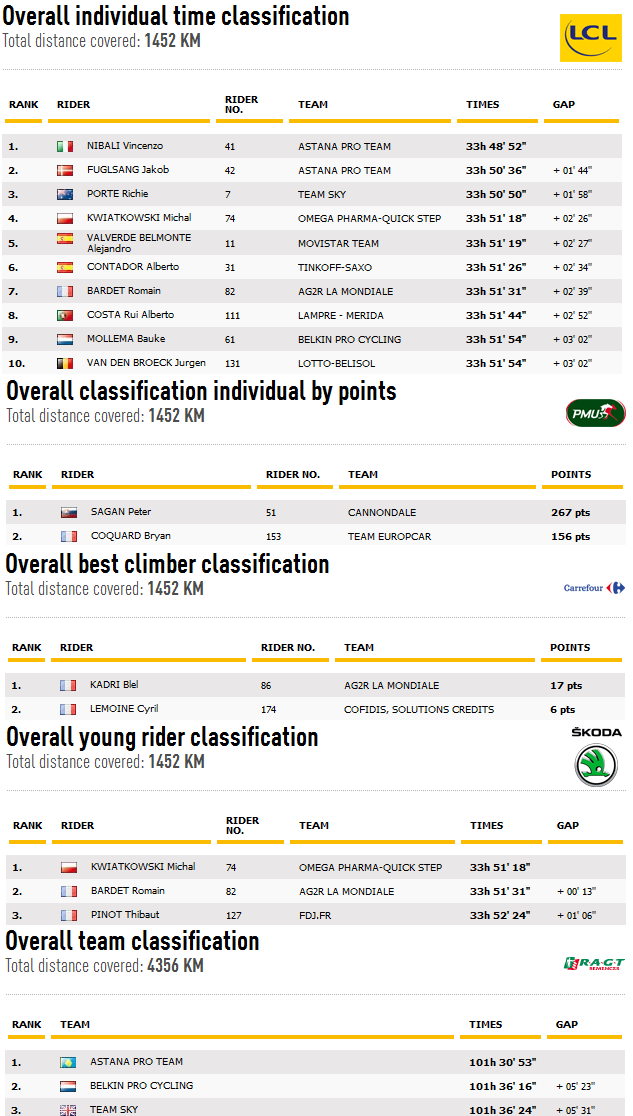
A big day of climbing but the route has the look of a decisive stage in reverse, a series of climbs followed by a flat run to the finish. Consequently it’s not as selective because the finish allows time for things to regroup. It’s a deliberate choice not to make the race too selective, instead it offers the certainty of a big breakaway. It’s all on tough roads where it will be hard to control and if a team or two wants to launch an ambush it can be done.
Stage 8 Wrap
A break of five riders went clear but only after a fierce struggle. Sylvain Chavanel said he averaged 60km/h for the first 40 minutes, an approximation but indicative all the same. He joined up with ex-team mate Niki Terpstra and then four more came across, Cofidis promising classics rider Adrien Petit, Simon Yates of Orica-Greenedge. Just getting in the break was hard work but you felt for Petit who is no climber. Yates is first year pro but his reputation precedes him and the others didn’t want to take him to the finish. Sylvain Chavanel attacked but got caught and passed by Kadri who just kept extending his lead on his way to the stage win. Kadri’s been tipped for some big wins but it hadn’t happened untl yesterday. France’s best U-16 rider, there’s more reading if you want. Note he was on the podium and had his team mates cheering below as well as Cannondale’s Jean-Marc Marino.

Behind we got the first look at Tinkoff-Saxo’s plans to overthrow Vincenzo Nibali. It was classic stuff as the fluo yellow jerseys hit the front of the peloton on the first climb and turned up the pace. One by one the team’s riders set the pace then dropped off once they could do no more. Meanwhile Astana riders were visible but not next to Nibali; Jacob Fuglsang’s got stomach troubles. Tinkoff-Saxo’s pace helped thin the field on the way to Gérardmer – Chris Horner was dropped – but so did the long descent down the Col de la Grosse Pierre where the wet conditions saw riders sliding, notably Andrew Talansky who lost two minutes to his rivals.
Onto the final climb and Nicolas Roche pulled off to leave Contador. We briefly saw Movistar set the pace before Contador attacked. It was a tough acceleration but the first of several. Nibali matched him all the way until right at the end where he surrendered a few seconds. Behind Richie Porte kept the pair in sight and then Thibaut Pinot was next, no descending worries for him.

Can we extrapolate from this short climb? Yes as it was a pure test of W/kg and the pecking order goes Contador-Nibali with Porte nearby. But don’t go too far it was one day the race has yet to cross a single first category climb yet alone ride to a true summit finish. To borrow from tennis yesterday was advantage Contador but he didn’t even win the game, yet alone the set. He needs 30 seconds per mountain stage, not three.
The Route
- Km 11.5 – Col de la Schlucht (1,140 m), 8.6 kilometre-long climb at 4.5% – category 2
- Km 41.0 – Col du Wettstein, 7.7 kilometre-long climb at 4.1% – category 3
- Km 70.0 – Côte des Cinq Châteaux, 4.5 kilometre-long climb at 6.1% – category 3
- Km 86.0 – Côte de Gueberschwihr (559 m), 4.1 kilometre-long climb at 7.9% – category 2
- Km 120.0 – Le Markstein (1,183 m), 10.8 kilometre-long climb at 5.4% – category 1
- Km 127.0 – Grand Ballon, 1.4 kilometre-long climb at 8.6% – category 3
“Not a metre of flat road for the first 130km” boasts the race directors. It’s uphill right from the start and continues for hours over wooded climbs on twisty roads where the average gradients for the climbs above are one thing and the reality is another when the slope keeps changing. It’s scenic, a route to ride for yourself another day because it’s challenging but never humiliating, a series of climbs and rewarding descents.
Look at the profile and you’ll see the Col du Banstein isn’t categorised despite being a named mountain pass. It’s another difficulty to add to the day before the long climb up the Grand Ballon. Commercial impeatives see the small ski resort of “Le Markstein” claim the first category climb for itself when it’s really just part of the road up to the top of the Grand Ballon. It’s a touch sad to read this because it relegates the wonderful Grand Ballon to a mere third category climb when it’s such a special climb:
- King of the Mountains: the phrase “King of the Mountains” comes from 1905 when René Pottier climbed the Grand Ballon, the first mountain ever climbed in the Tour (but not the first mountain pass). Riding for a team with Peugeot bikes, the company’s factory was down the road and workers lined the climb. The spectacle was so great that newspaper L’Auto proclaimed Pottier as “le roi de la montagne“, or the king of the mountain.

The Finish: flat and with few obstacles, the opposite of the rest of the route.
The Scenario: The Strava record for the Col de la Schlucht should get updated. An early move can go but it could be brought back if a team feels they’ve missed it. Easier said than done and we should see some strong riders barge away on the first climb and the ensuing descent.
Why isn’t this for the GC riders? Because they’d probably sit tight until the Grand Ballon, the big final climb of the day and if they launched a move on here there’s still over 40km to the finish, it’s hard to keep going if a team chases behind.
However there remains the outside chance of a team trying to rip up the race. Many of the contenders for yellow jersey and their team mates will be thinking of tomorrow’s climbs and hoping for some rest so it’s perfect for an ambush, a surprise attack. Garmin-Sharp are the masters of this but at the same time we half expect them to try it.
The Contenders: Peter Sagan is a default pick because he could try to get in the breakaway but he could sit back in the bunch with the hope it comes together again. The final climb up the Grand Ballon via Markstein isn’t steep so he can hang tight and besides for all the climbing there’s plenty of descending and he’s at ease here. But the Slovak’s still a low probability and if he’s around, he might find Matteo Trentin on his wheel too.
Given the random nature of the breakaways it’s tough to pick some names. Yesterday saw Pierre Rolland try to go clear early on but he was reeled in. He could try again unless he’s saving himself for tomorrow’s Bastille Day stage and he might prefer it, he looked rinsed on the Col de Grosse Pierre yesterday. So perhaps team mates Thomas Voeckler and Cyril Gauthier are better picks? Tony Gallopin and even more so Arthur Vichot, the local rider, are worth watching.
We can cite some other breakaway names like Simon Gerrans and Michael Albasinin, Ramunas Navardauskas, Jan Bakelants, Katusha’s Simon Špilak and Yuri Trofimov but it’s still early in the race to discover who the breakaway riders are. Tony Martin’s said to have personal ambitions for a road stage in the race and if so he’ll be trying soon so that he gets some recovery time in the Pyrenees before his tilt at the Stage 20 time trial.
Otherwise maybe Andrew Talansky does a Dauphine and takes some risks to avenge his crashes? Probably not but he’s punchy if a group comes in.
| – | |
| – | |
| Peter Sagan | |
| Pierre Rolland, Tony Gallopin, Simon Gerrans | |
| Talansky, Kwiatkowski, Chérel, Navardauskas, Tony Martin |
Weather: sunshine and clouds but the risk of a thunderstorm. Top temperatures of 21°C await at the finish if the rain stays away.
TV: live from around 2.00pm Euro time which means we’ll miss 45 minutes of the stage. Tune in early to check what’s happening. The big climb up Markstein starts around 4.00pm with the finish as usual for 5.30pm local time.

